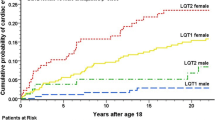Abstract
β-Blocker therapy is one of the principal therapies for congenital long-QT syndrome (LQTS). However, breakthrough cardiac events occur while being treated with β-blockers. We sought to determine the frequency of and clinical correlates underlying β-blocker therapy failures in genotyped, symptomatic LQTS probands. The medical records were analyzed only for genotyped LQTS probands who presented with a LQTS-attributable clinical event and were receiving β-blocker therapy. The study cohort comprised 28 such patients: 18 KCNQ1/KVLQT1(LQT1), 7 KCNH2/HERG (LQT2), and 3 SCN5A (LQT3). The prescribed β-blocker was atenolol (12), propranolol (10), metoprolol (4), and nadolol (2). β-Blocker therapy failure was defined as breakthrough cardiac events including syncope, aborted cardiac arrest (ACA), appropriate implantable cardioverter-defibrillator (ICD) therapy, or sudden death occurring while on β-blocker therapy. During a median follow-up of 46 months, 7/28 (25%) LQTS probands experienced a total of 15 breakthrough cardiac events. Their initial presentation was ACA (3), bradycardia during infancy (2), and syncope (2). The underlying genotype was KVLQT1 (6) and HERG (1). Two breakthroughs were attributed to noncompliance. Of the 13 breakthroughs occurring while compliant, 10 occurred with atenolol and 3 with propranolol (p = 0.03). In this study cohort, one-fourth of genotyped LQTS probands failed β-blocker therapy. Treatment with atenolol, young age at diagnosis, initial presentation with ACA, KVLQT1 genotype, and noncompliance may be important factors underlying β-blocker therapy failures.


Similar content being viewed by others
References
M Ackerman (1998) ArticleTitleThe long QT syndrome: ion channel disease of the heart. Mayo ClinProc 73 250–269 Occurrence Handle1:STN:280:DyaK1c7nt1OktA%3D%3D
MJ Ackerman A Khositseth DJ Tester JB Hejlik WK Shen CB Porter (2002) ArticleTitleEpinephrine-induced QT interval prolongation: a gene-specific paradoxical response in congenital long QT syndrome. Mayo Clin Proc 77 413–421 Occurrence Handle1:CAS:528:DC%2BD38XjvFOitrk%3D Occurrence Handle12004990
MJ Ackerman DJ Tester CJ Porter (1999) ArticleTitleSwimming, a gene-specific arrhythmogenic trigger for inherited long QT syndrome. Mayo Clin Proc 74 1088–1094 Occurrence Handle1:CAS:528:DyaK1MXnslGju7w%3D Occurrence Handle10560595
PC Dorostkar M Eldar B Belhassen MM Scheinman (1999) ArticleTitleLong-term follow-up of patients with long-QT syndrome treated with beta-blockers and continuous pacing. Circulation 100 2431–2436 Occurrence Handle1:CAS:528:DC%2BD3cXisVKltQ%3D%3D Occurrence Handle10595956
T Itoh K Kikuchi Y Odagawa et al. (2001) ArticleTitleCorrelation of genetic etiology with response to beta-adrenergic blockade among symptomatic patients with familial long-QT syndrome. J Hum Genet 46 38–40 Occurrence Handle10.1007/s100380170123 Occurrence Handle1:CAS:528:DC%2BD3MXoslynsw%3D%3D Occurrence Handle11289718
EH Locati PJ Schwartz (1992) ArticleTitleThe idiopathic long QT syndrome: therapeutic management. Pacing Clin Electrophysiol 15 1374–1379 Occurrence Handle1:STN:280:ByyD38jmtV0%3D Occurrence Handle1384000
AJ Moss W Zareba WJ Hall et al. (2000) ArticleTitleEffectiveness and limitations of beta-blocker therapy in congenital long-QT syndrome. Circulation 101 616–623 Occurrence Handle1:CAS:528:DC%2BD3cXhtlGntLw%3D Occurrence Handle10673253
PJ Schwartz E Locati (1985) ArticleTitleThe idiopathic long QT syndrome: pathogenetic mechanisms and therapy. Eur Heart J 6 IssueIDSuppl D 103–114
PJ Schwartz M Periti A Malliani (1975) ArticleTitleThe long Q-T syndrome. Am Heart J 89 378–390 Occurrence Handle10.1016/0002-8703(75)90089-7 Occurrence Handle1:STN:280:CSqC3cnjslc%3D Occurrence Handle234667
PJ Schwartz SG Priori C Spazzolini et al. (2001) ArticleTitleGenotype-phenotype correlation in the long-QT syndrome: gene-specific triggers for life-threatening arrhythmias. Circulation 103 89–95 Occurrence Handle1:STN:280:DC%2BD3M%2FovVSitg%3D%3D Occurrence Handle11136691
W Shimizu C Antzelevitch (2000) ArticleTitleDifferential effects of beta-adrenergic agonists and antagonists in LQT1, LQT2 and LQT3 models of the long QT syndrome. J Am Coll Cardiol 35 778–786 Occurrence Handle10.1016/S0735-1097(99)00582-3 Occurrence Handle1:CAS:528:DC%2BD3cXitVCjsbc%3D Occurrence Handle10716483
W Shimizu S Kamakura T Kurita K Suyama N Aihara K Shimomura (1997) ArticleTitleInfluence of epinephrine, propranolol, and atrial pacing on spatial distribution of recovery time measured by body surface mapping in congenital long QT syndrome. J Cardiovasc Electrophysiol 8 1102–1114 Occurrence Handle1:STN:280:DyaK1c%2FivVCnsQ%3D%3D Occurrence Handle9363813
W Shimizu T Ohe T Kurita et al. (1995) ArticleTitleEffects of verapamil and propranolol on early after depolarizations and ventricular arrhythmias induced by epinephrine in congenital long QT syndrome. J Am Coll Cardiol 26 1299–1309 Occurrence Handle10.1016/0735-1097(95)00313-4 Occurrence Handle1:CAS:528:DyaK28XjsFGg Occurrence Handle7594047
GM Vincent PJ Schwartz H Swan K Piippo C Bithell (2001) ArticleTitleEffectiveness of beta-blockers in the LQT1 genotype of long QT syndrome [abstr]. Circulation 104 IssueIDSuppl II II-462
OC Ward (1964) ArticleTitleNew familial cardiac syndrome in children. J Irish Med Assoc 54 103–106 Occurrence Handle1:STN:280:CCuD1MvntlI%3D
W Zareba AJ Moss PJ Schwartz et al. (1998) ArticleTitleInfluence of genotype on the clinical course of the long-QT syndrome. International Long-QT Syndrome Registry Research Group. N Engl J Med 339 960–965 Occurrence Handle10.1056/NEJM199810013391404 Occurrence Handle1:STN:280:DyaK1cvhvVKntQ%3D%3D Occurrence Handle9753711
Acknowledgment
This work was supported by a Clinical Scientist Development Award to MJA from the Doris Duke Charitable Foundation.
Author information
Authors and Affiliations
Corresponding author
Rights and permissions
About this article
Cite this article
Chatrath, R., Bell, C.M. & Ackerman, M.J. β-Blocker Therapy Failures in Symptomatic Probands with Genotyped Long-QT Syndrome. Pediatr Cardiol 25, 459–465 (2004). https://doi.org/10.1007/s00246-003-0567-3
Published:
Issue Date:
DOI: https://doi.org/10.1007/s00246-003-0567-3




